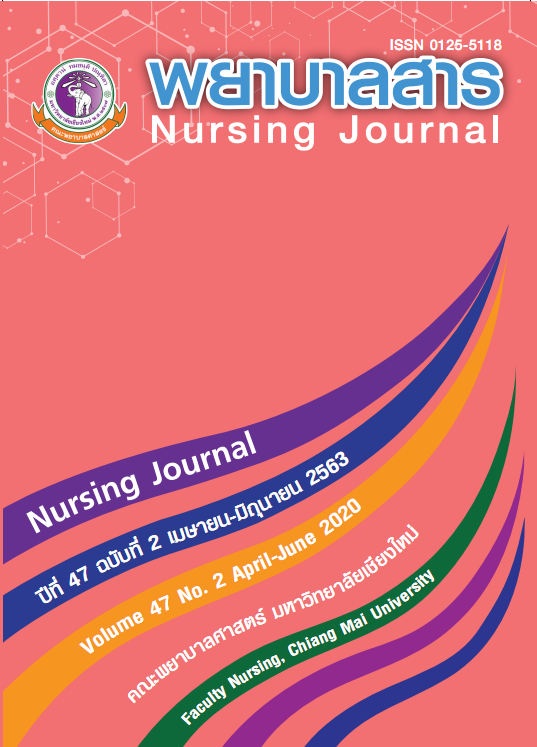Development of a Community Participation Caring Model for People with Diabetes Mellitus
Keywords:
Community Participation, Development of Caring Model, Peoples with Diabetes MellitusAbstract
This developmental research study aimed to develop a community participation caring model for peoples with diabetes mellitus and to study the effectiveness of this model for peoples with diabetes mellitus in terms of knowledge about the disease and their practice. The community participation concept developed by Cohen and Uphoff (1977) was used in this study which includes three phases. the first phase was situational analysis, the second phase was Implementation that develop in the first phase and the third phase was evaluated of the intervention. The study used purposive sampling to select all the participants who have diabetes mellitus. Sample had 4 groups who participated were composed of people with diabetes mellitus, Care givers, nurses, primary care unit personal, health volunteer and municipality personal total 33 person. This sample size was identified from the effect size at 0.50 the level of statistical significance at .05. The researcher considered increasing the sample size by 20% for the loss. There was a total of twenty-seven participants who were included in the study. The instrument in this research study included: knowledge of diabetes mellitus, self-care practice measures, a community participation caring model, the guideline questions for assessment and analyzing for people with diabetes mellitus, , primary care unit personals, health volunteers, care givers, and a self-care guideline book for people with diabetes mellitus.
The results of developing a community participation caring model for peoples with diabetes mellitus were as follows: 1) A community participation caring model, self-care practice, home visits by a home health care team, and guideline book for people with diabetes mellitus. 2) The effectiveness of a community participation caring model for peoples with diabetes mellitus showed that a level of knowledge after following the community participation caring model for peoples with diabetes mellitus, 74% of the participants increased their knowledge about diabetes mellitus; and a level of practice about self-care after following the community participation caring model for peoples with diabetes mellitus, 70.4% of the participants increased their self-care practice.
The development of a community participation caring model for peoples with diabetes mellitus would increase their knowledge and their self-care practice. Therefore, the guidelines of a development of a community participant caring model for peoples with diabetes mellitus could be applied to promote self-care and practice among people with diabetes mellitus in a community for the prevention.
References
Aslak, S., Lisbth, R., Monde, L., & Atle, F. (2012). Group based diabetes self-management education compared to routine treatment for people with type 2 diabetes mellitus. Retrieved from http://www.biomedcentral.com/1472-6963/12/213
American Diabetes Association [ADA]. (2013). Standards of medical care in diabetes 2013. Retrieved from http://care.diabetesjournals.org
Burns, N., & Grove, S. K. (2009). The practice of nursing research: Appraisal, synthesis, and generation of evidence. (6th ed.). Missouri: Elsevier.
Chaiyarit, A., & Jansombatsiri, W. (2017). Significant role of nurse case manager to improve quality of care for chronically ill patients: Diabetes and hyp ertensive patients. Nursing Journal, 44 (4), 195-205. (In Thai)
Choeichum, S. (2017). Method of preventing and health care of patients who have diabates by the participation of community: A case study of Nongbuanua Comm unity, Satuk District, Burirum Province. Retrieved from http://elibrary.trf.or.th/project_contentTRFN.as p?PJID=RDG51E0095. (In Thai)
Cohen, J. M., & Uphoff, N. T. (1977). Rural Development Participation: Concept and Measures for Project Design. New York: Rural Development Committee.
David, R., Leonor, G., Clara, W., & Jonathan, S. (2011). IDF diabetes atlas: Global estimates of the prevalence of diabetes for 2011 and 2030. Diabetes Research and Clinical Practice, 94, 311-321.
Institute for Community Health System Research and Development . (2009). Primary care unit guideline: Diabetes management. Bangkok: Holistic Publishing. (In Thai)
Kosonjit, R., & Noimuenwai, P. (2017). Effective of case manag ement in patients with diabetic millitus at Pak Phli Hospital, Nakhon Nayok Province. Nursing Journal, 44 (1), 26-38. (In Thai)
National Health Security Office [NHSO]. (2007). National Health Security Guideline. Bangkok: [n.p.] (In Thai)
National Health Security Office [NHSO]. (2011). Clinical practice guidelines for diabetes 2011.Bangkok: Srimuang Publisher. (In Thai)
Non-Communicable Disease, Ministry of Public Health. (2012). Diabetes Patient Report. Retrieved from http://www.thaincd.com/webboard-view.php?id=1320 (In Thai)
Peeraprutpong, N., Pakdeewong, N., & Namwongprom, A. (2012). Effects of self-management program on knowledge, self-care activities, and HbA1c in persons with type 2 diabetes.Journal of Nursing and Health Care, 30 (2), 98–105. (In Thai)
Phongprapapan, P., Sanveingchan, S., & Panya, P. (2013). Models to promote integral health care in diabetic patients at Wat Puranawas Community. Nursing Journal of the Ministry of Public Health, 22(3), 100-111. (In Thai)
Piromchom, A., & Hansaku, A. (2018). Perceived health and facto rs associated with self-care behaviors in type II diabates mellitus patients in Nongbuarawae District, Chaiyaphum Province. Journal of Prevention and Control Disease 6 region, 15 (1), 1-10. (In Thai)
Sintunankul, S., & Chompoopruk, S. (2013). The effect of a sel f-care behavior in type 2 diabetes patients. Khon Kaen Medical Journal, 37 (2), 24–30. (In Thai)
Srisong Muang Tumbon Health Promotion Hospital. (2014). Srisong Muang Tumbon healthpromotion hospital annual report. Chiangmai: Srisong Muang Tumbon Health Promotion Hospital. (In Thai)
Downloads
Published
How to Cite
Issue
Section
License
บทความที่ได้รับการตีพิมพ์เป็นลิขสิทธิ์ของวารสารพยาบาลสาร
ข้อความที่ปรากฏในบทความแต่ละเรื่องในวารสารวิชาการเล่มนี้เป็นความคิดเห็นส่วนตัวของผู้เขียนแต่ละท่านไม่เกี่ยวข้องกับมหาวิทยาลัยเชียงใหม่ และคณาจารย์ท่านอื่นๆในมหาวิทยาลัยฯ แต่อย่างใด ความรับผิดชอบองค์ประกอบทั้งหมดของบทความแต่ละเรื่องเป็นของผู้เขียนแต่ละท่าน หากมีความผิดพลาดใด ๆ ผู้เขียนแต่ละท่านจะรับผิดชอบบทความของตนเองแต่ผู้เดียว






